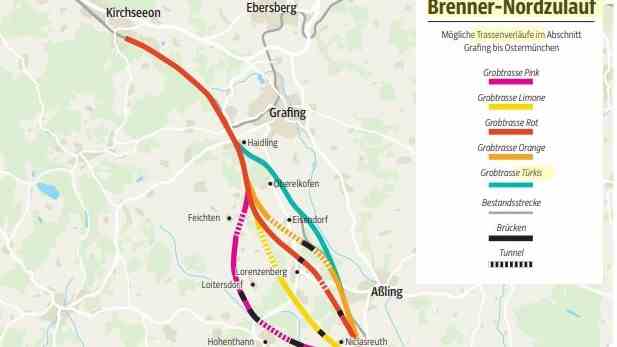The route for the northern access to the Brenner Pass through the district of Ebersberg, and thus also for the entire connection from Munich to northern Italy, has been determined: As Deutsche Bahn announced on Wednesday, the choice fell on the so-called “Limone” main route. Coming from Ostermünchen in the district of Rosenheim, this runs directly past the small towns of Niclasreuth and Dorfen in the municipality of Aßling, before the new tracks at Lorenzenberg disappear into an approximately 1.5-kilometer-long tunnel. This ends at Hamberg, from where the route via Schammach and Taglaching near Kirchseeon is rejoined with the existing route. While the railway planners speak of a “milestone”, the anger of residents and politicians is great.
The railway planners have opted for the “Limone” variant as the selection route.
(Photo: oh)
Many of those affected would have preferred “turquoise” instead of “lime”, i.e. the construction of the new tracks in the immediate vicinity of the existing line west of Aßling. This option is based on an idea developed by Brucker Mayor Josef Schwäbl (CSU) and Asslinger project controller Andreas Brandmaier, and which many residents in the southern district would have been most comfortable with. But Deutsche Bahn is now taking a different approach, which was presented by overall project manager Matthias Neumaier and project section manager Dieter Müller on Wednesday at a press conference in Ebersberg.
The route came off best in the catalog of criteria
Accordingly, the freight trains on the Scandinavia-Mediterranean axis are to run significantly further to the west of the existing route through the Ebersberg district. “The Limone variant is not the cheapest, but the most balanced route,” said Matthias Neumeier. “We now have a route that is the most tolerable according to objective criteria.” This statement may seem daring at first glance, as the new rails lead through previously undeveloped landscape, but those responsible for the railway are convinced of the solution found. “The result is very, very clear,” said Neumeier, referring to the catalog of criteria on which it was based.
Overall project manager Matthias Neumaier, project section manager Dieter Müller and Bahn spokeswoman Kathrin Kratzer (from left) at the route presentation in the old cinema.
(Photo: Peter Hinz-Rosin)
The planners had worked this out in several dialogue forums with those affected and representatives of local politics. Each of the five possible routes was assessed under the three major themes of “Traffic and Technology”, “Space and Environment” and “Costs and Risks”. The track layout that has now been selected performed best in eleven of the 14 main criteria. The “Turquoise” variant, on the other hand, received a poor rating, especially in the “People – Health and Well-Being” criterion. The “Red” and “Pink” options performed poorly in “Soil, Agriculture and Forestry” and “Orange” underperformed in the “Animals, Plants and Biodiversity” area.
Unlike other variants, no buildings have to be demolished
From a technical point of view, however, the “Limone” selection route has the least impact on people and the environment, as the railway planners explained. “There are no interventions in the residential development,” as Matthias Neumeier said. “So we won’t have to demolish any buildings.” In addition, the route largely runs in a depression below the surrounding terrain. This protects the landscape and already does something for noise protection. Incidentally, the planners consider this to be harmless despite the increased number of trains, since freight trains will be running on the new line in the future. “We’re relieving the load on the existing line. So it’s automatically quieter there,” said Neumeier. There will therefore be no structural changes for better noise protection in the Aßling area, as Dieter Müller added. Nevertheless, the project section manager assured: “It will be much quieter.”
This is unlikely to apply to the coming weeks and months. In order to inform openly about the result, as those responsible for the railways said, so-called information markets should be set up in the affected communities, where citizens can ask their questions: on July 19th in the Grafing rectory, on July 20th at the church square in Aßling and on July 21st at Landgasthof Wallner in Tuntenhausen – from 4 p.m. to 8 p.m. It is rather doubtful that the plans presented by the railways will meet with broad approval there. Things had already gotten quite emotional in a dialogue forum on Wednesday morning, as moderator Ralf Eggert later reported at the press conference. The participants therefore did not expect this result. “It was clearly said that one would have liked turquoise,” says Eggert.
The route still has to be planned in detail
This train has now left, however, further preliminary planning will deal with the course of the “Limone” variant up to the year 2024. “We are still very roughly on the way,” said Matthias Neumeier. Now it is time to check the track layout in detail. “The aim is to optimize the course of the route,” says the overall project manager, who also did not rule out a longer tunnel route than the 1.5 kilometers previously planned. How deep the rails are to be laid below the surface of the terrain must also be clarified in the coming months.
It will still be a long time before the entire northern inlet to the Brenner Pass is completed. The start is currently planned for 2040. The train route from Munich via Austria to Verona should then become one of the central transport routes for goods within Europe. The aim of the mega-project is to relieve the motorways and at the same time make a contribution to climate protection. The start of construction for the section in the district of Ebersberg is planned for the early 2030s.

